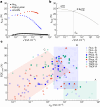A figure of merit for efficiency roll-off in TADF-based organic LEDs
- PMID: 38538942
- PMCID: PMC10972759
- DOI: 10.1038/s41586-024-07149-x
A figure of merit for efficiency roll-off in TADF-based organic LEDs
Abstract
Organic light-emitting diodes (OLEDs) are a revolutionary light-emitting display technology that has been successfully commercialized in mobile phones and televisions1,2. The injected charges form both singlet and triplet excitons, and for high efficiency it is important to enable triplets as well as singlets to emit light. At present, materials that harvest triplets by thermally activated delayed fluorescence (TADF) are a very active field of research as an alternative to phosphorescent emitters that usually use heavy metal atoms3,4. Although excellent progress has been made, in most TADF OLEDs there is a severe decrease of efficiency as the drive current is increased, known as efficiency roll-off. So far, much of the literature suggests that efficiency roll-off should be reduced by minimizing the energy difference between singlet and triplet excited states (ΔEST) to maximize the rate of conversion of triplets to singlets by means of reverse intersystem crossing (kRISC)5-20. We analyse the efficiency roll-off in a wide range of TADF OLEDs and find that neither of these parameters fully accounts for the reported efficiency roll-off. By considering the dynamic equilibrium between singlets and triplets in TADF materials, we propose a figure of merit for materials design to reduce efficiency roll-off and discuss its correlation with reported data of TADF OLEDs. Our new figure of merit will guide the design and development of TADF materials that can reduce efficiency roll-off. It will help improve the efficiency of TADF OLEDs at realistic display operating conditions and expand the use of TADF materials to applications that require high brightness, such as lighting, augmented reality and lasing.
© 2024. The Author(s).
Conflict of interest statement
The authors declare no competing interests.
Figures








References
-
- Hu YX, et al. Efficient selenium-integrated TADF OLEDs with reduced roll-off. Nat. Photonics. 2022;16:803–810. doi: 10.1038/s41566-022-01083-y. - DOI
LinkOut - more resources
Full Text Sources

